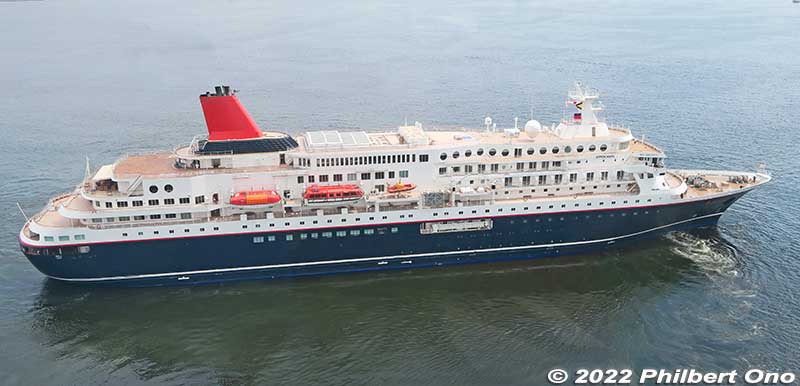
by Philbert Ono, Updated: May 5, 2023
First in a series of blog posts on luxury cruising, cruise ships, and cruise ports in Japan in 2022.
In early summer 2022 when COVID-19 cases in Japan were relatively low, I had the chance to cruise up and down the Japanese archipelago on a Japanese luxury cruise ship. Good experience. The cruise ship, crew, and ports of call were great.
It was quite safe. All passengers were PCR-tested a few days before departure and again on the departure day. The ship operated with reduced passenger capacity to avoid overcrowding, and everyone wore masks. The Japanese cruise industry, passengers, and crew have gone the extra (nautical) mile to minimize the risk and maximize everyone’s health and safety.

Japan has three major Japanese cruise ships: Asuka II, Pacific Venus (retired in Jan. 2023), and Nippon Maru, homeported in Yokohama, Osaka, and Tokyo, respectively. After suspending cruising from March to autumn 2020 due to the COVID-19 pandemic, luxury cruising restarted in Japan in October 2020.
It hasn’t been smooth sailing though. Cruise ships have had to cut through waves of COVID-19 and obey “State of Emergency” declarations which discouraged unnecessary travel. They have been doing their best to overcome the adversity. However, one major casualty is the Pacific Venus when it stopped operations after its New Year’s 2023 cruise ended on Jan. 4, 2023. Its parent company decided to quit the cruise business. There are now only two Japanese cruise ships.
In 2022, we still saw waves of COVID-19, but at least no “State of Emergency.” People and cruise ships were finally free to travel in Japan in 2022 while following standard precautions such as wearing a mask. Buoyed by returning Japanese cruise fans, the three Japanese cruise ships offered mostly short cruises one to five nights long all over Japan.
Passengers are almost exclusively Japanese. Basically zero foreigners. I saw mostly elderly couples and retirees sprinkled with a few honeymooners. A rare tourist attraction in Japan not yet infiltrated by foreign tourists. (Foreigners normally cruise on international cruise ships instead.)
The official language on board is Japanese, so everything is in Japanese. Even official websites are in Japanese only. If you want to make reservations, you need to read Japanese or go through a travel agent. You must also be a Japan resident.
Despite expensive cruise fares, all three Japanese cruise ships have been operating in the red. However, each ship is backed by a large maritime transport company. Asuka II and Nippon Maru are backed by two of Japan’s largest maritime shipping companies, NYK Line and Mitsui O.S.K. Lines, respectively, while Pacific Venus was backed by a consortium of ferry companies named Shin Nihonkai Ferry Co., Ltd. The parent companies operate many other ships, mostly container, cargo, and/or ferries.
With such corporate backing, there’s little chance of any Japanese luxury cruise line going under. The cruise ship is like the corporate PR flagship and status symbol. The glamorous showpiece among rank-and-file container/cargo ships and car ferries. It must keep sailing. However, Pacific Venus sadly announced on Nov. 1, 2022 that it would retire after its last cruise in Jan. 2023.
Normally, international (foreign) cruise ships also operate in Japan and offer international cruises starting and ending in Japan. Or they cruise from overseas and visit Japan as part of their itinerary. Japan has been a popular port of call for international cruise ships.
However due to the COVID-19 pandemic, international cruising in Japan has been suspended since March 2020. International cruise ships are not allowed to enter Japan, and Japanese cruise ships are not allowed to sail overseas with passengers. In 2022, Japanese cruise ships did not allow passengers who had been abroad during the last two weeks before the cruise’s departure date.
Although Japan has been slowly opening up international air travel until its complete reopening on October 11, 2022, no progress has been reported for international cruising as of mid-October 2022.
(Update: On Nov. 15, 2022, Japan’s Ministry of Transport finally announced that Japan would reopen to international cruises. Nippon Maru went on its first overseas cruise in almost three years in Dec. 2022, and International cruise ships will start arriving in Japan in March 2023.)
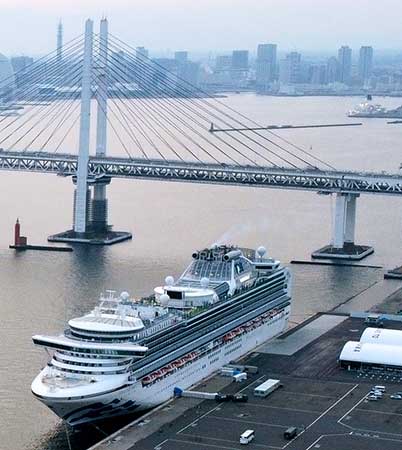
Many people in Japan may associate luxury cruising with the infamous Diamond Princess which brought COVID-19 to Yokohama on February 2, 2020. Among 3,711 crew and passengers (including 1,281 Japanese nationals), 712 got infected (including 270 Japanese) and at least 13 died of the disease.
The shock and trauma of that debacle still casts a long shadow on the industry in Japan. With “Never again” as the industry’s unspoken motto, Japanese cruise ships have since formulated and implemented strict COVID-19 safety and health protocols. (Details here.)
To their credit, Japanese cruise ships have never had a COVID-19 outbreak nor major cluster on board so far. However, waves of COVID-19 have inevitably splashed isolated cases aboard almost monthly, especially in summer of 2022 when the huge seventh wave of COVID-19 Omicron variants swept across Japan.
Each onboard case of COVID-19 (usually a crew member) resulted in the cancelation of the current and/or next cruise. Between July and September 2022, there were Japanese cruise ships laying idle for one or two weeks or longer.
Each isolated case has been dealt with an iron hand by isolating the infected individual(s), closing ship facilities, confining passengers to their cabins, and canceling the cruise. It’s a real pain, but “Safety first” is the perennial slogan.
Cruise ships and passengers have no choice but to accept the risk, uncertainty, and new normal of co-existing with coronavirus or “with corona” as the Japanese call it. Japanese ferries also had isolated COVID-19 cases among essential crew members this summer, forcing a few ferry runs to be canceled.

Cruise ships are welcome most everywhere in Japan, and they usually receive welcome and sendoff ceremonies at dockside by local people.
Many ports have been trying to attract cruise ships by building cruise terminals or docks, nearby tourist attractions, etc. The Japanese government encourages cruise ships to visit more ports. You’re lucky if your ship is visiting a port for the first time. It’s making local history.
Overtourism and air pollution by cruise ships at Japanese ports are not yet recognized as a serious problem. Japan’s cruise industry is not that big, Japanese cruise ships are not mega-ships, and they don’t usually stay in port for long.
Since there’s so little English information on Japan’s cloistered cruise industry, I’ve written this comprehensive overview. It’s time to crack open and throw light on this closed, niche industry. For anybody who’s interested.
Contents
State of Japanese Cruise Industry in mid-2022 (current page)
- COVID-19 not over yet
- International cruise ships in Japan
- Japan still closed to international cruising
- Essential Japanese Vocabulary
- Ship comparison
- Japanese cruise ship advantages
- COVID-19 protocols
- Basic cruise rules
- Safety Record
- FAQ
- Asuka II
- Pacific Venus
- Nippon Maru
Ports for Cruise Ships in Japan
- Cruise ship departure ports
- Japan’s popular ports of call
- Shore excursions
- Mega-ships and harbor bridges
- Japanese port history
- Port town songs
- Yokohama | Tokyo | Kobe | Hakodate | Nagoya | Kanazawa | Toyama
Japan’s Top 10 Cruises & Destinations
Coming soon.
State of the Japanese cruise industry in 2022
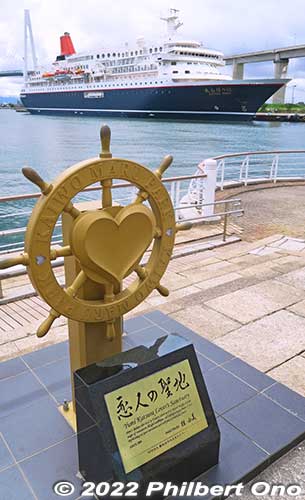
Before the pandemic hit, Japan’s cruise industry looked promising with steady growth. The luxury cruise population was steadily increasing until it peaked in 2019 with 356,600 cruisers.
Japan was also a popular port of call with international cruise ships visiting Japanese ports 1,932 times in 2019, bringing 2,153,000 inbound passengers, a 12.2 percent increase over 2018.
About 80 percent of cruise ship visitors came from China, and 13 percent from Taiwan. During 2018–2020, Asia was the world’s second most popular cruise destination after the Caribbean, Bahamas, and Bermuda region. It was enough to spur Japanese ports to build cruise ship docks or terminals.
Japan’s three major cruise ships Asuka II (飛鳥II), Pacific Venus (ぱしふぃっくびいなす), and Nippon Maru (にっぽん丸) are medium-size ships with a passenger capacity of several hundred each.
Note that Pacific Venus has stopped sailing after its final voyage ended on Jan. 4, 2023. Ship owner Japan Cruise Line announced on Nov. 1, 2022 that it would pull out of the cruise ship business entirely after the Pacific Venus completes its New Year’s 2023 cruise to Okinawa and Amami Oshima. No announcement yet about the fate of the ship.
There’s also a boutique, luxury cruise boat named guntu (ガンツウ) cruising in the Seto Inland Sea and homeported in Onomichi (Bella Vista Marina), Hiroshima. It’s a high-class, floating ryokan with 19 wooden cabins for a maximum 38 guests. Very expensive. Kudos to them for being the only Japanese cruise vessel to have an official website in English. For the purposes of this blog article though, I’m excluding guntu when I say “Japanese cruise ships” because guntu is in a class by itself.
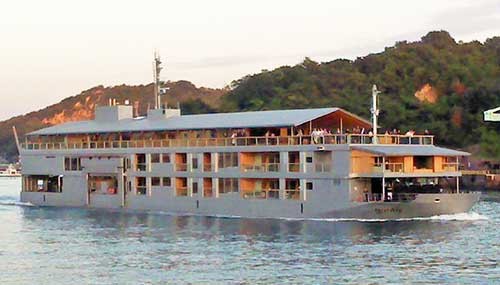
After the Japanese government lifted the COVID-19 State of Emergency in September 2020, the three major cruise ships restarted in October-December 2020. (Guntu restarted in July 2020.)
However, each time the dreaded State of Emergency was declared again (discouraging travel to other prefectures), cruise ships had to stay home because port cities did not want them to come.
The year 2021 was slightly better than 2020. Although Japanese cruise ships were allowed to sail, COVID-19 waves kept rolling in especially during and after major holiday periods. Cruise ships ended up canceling many of their cruises from January to autumn 2021.
Cancelations were due to port cities denying visitors from other prefectures (during “State of Emergency”), crew members testing positive for COVID-19, the cruise not getting enough passengers, or an imminent typhoon (in summer).
From summer 2021, Japanese cruise lines started implementing PCR testing (saliva sample) on the departure day in addition to pre-departure testing. This was another major preventive measure against bringing coronavirus on board.
Unlike other tourism sectors (airlines, tour buses, hotels, etc.), the struggling cruise industry in dire straits hardly made mainstream news after the Diamond Princess left Japan in March 2020. The media fixated more on how the Tokyo 2020 Olympics could be held amid the pandemic.
In 2022, with most of the population vaccinated, Japanese cruise ships had an easier time, but cruises were still sporadic at times with cruises being canceled right after major holiday periods such as New Year’s, Golden Week (late April to early May), and summer (July–August). Main reasons were again ports of call denying outside visitors and isolated cases among the crew.
Fortunately, Japanese cruise ships have never had a major COVID-19 outbreak. Only isolated cases, mostly among the crew. The numbers have always been low. This means their COVID-19 safety protocols have been largely effective.
With international cruise ships barred from Japan until Nov. 2022, Japanese cruise ships enjoyed a monopoly in luxury cruising in Japan. However, they can never be totally happy unless they can also cruise overseas and COVID-19 is effectively suppressed.
(Update: On Nov. 15, 2022, Japan’s Ministry of Transport announced that Japan will allow international cruising and reopen ports to international cruise ships.)
*More about Japanese cruise ships here.
COVID-19 not over yet on Japanese cruise ships as of mid-2022

From early July 2022, a record-breaking, seventh wave of COVID-19 swept Japan. Previous COVID-19 waves in Japan looked like pimples and molehills on the statistical graph. Now it looked like the Matterhorn in summer 2022. How can this happen in a country where most everyone wears a mask? More cases than even the U.S. Unbelievable.
While the CDC in the U.S. and international cruise ships have been loosening their COVID-19 protocols, Japan’s COVID-19 protocols remain largely intact. With isolated cases still occurring on board, nobody in Japan is clamoring to loosen COVID-19 safety protocols on cruise ships just yet. Nobody wants to see another outbreak on a cruise ship. The ominous specter of the Diamond Princess runs deep.
Unlike cruise line executives in the U.S. and Europe declaring victory over COVID-19 (even as outbreaks keep occurring on their ships), absolutely no one in Japan is declaring victory over COVID-19. It’s an ongoing whack-a-mole battle with all these variants and isolated cases on board. The best we can do is minimize the risk, mitigate the impact of infections, and learn to work around it.
Japanese cruise ships are operating at 50 to 60 percent passenger capacity. Pre-departure PCR tests and masks are still required. Thermal scanning, plexiglass, and hand sanitizers are standard equipment on cruise ships.
Until July 31, 2022, Japanese cruise industry guidelines stipulated that if even one crew member or passenger is found to have COVID-19, the person is to be isolated, all facilities used by the infected person and close contacts are to be disinfected, all the ship’s public facilities are to be closed, all activities for passengers are to be suspended, all other passengers are to be confined to their cabins with food delivered to them, and the rest of the cruise is to be canceled.
The infected person(s) is to disembark at the nearest port and follow the instructions of local health authorities. The next scheduled cruise is also canceled to disinfect the ship.
To alleviate the frustrating and costly consequences of these isolated cases, the Japanese cruise industry association revised its COVID-19 safety guidelines for the seventh time on July 31, 2022. (The 8th revision was issued in Nov. 2022.)
According to the revised guidelines, Japanese cruise ships are now allowed to continue the cruise even if only one isolated COVID-19 case is found. The infected person and any close contacts are to isolate and disembark at the nearest port of call. The rest of the cruise can continue.
The cruise must be canceled only if two or more isolated cases are found or if there’s a cluster of five or more people. These revised guidelines are now in effect on all three Japanese cruise ships since August 2022.
Japanese cruise lines have been transparent about their COVID-19 cases and subsequent cruise cancelations. They have been posting notifications on their official websites for each reported case and cruise cancelation. The case numbers are always very low.
However, isolated cases on board have become more frequent since early July 2022 with the seventh wave of COVID-19. Asuka II canceled about half of its cruises scheduled in August and September 2022 due to infected crew members. No passengers were on board when infected crew members were found. The other two ships also canceled a number of cruises in summer due to onboard cases.
Many major festivals, fireworks, and other events have been held in Japan this summer for the first time since 2019. Lots of people went out and about. As a result, more people have been getting infected. Nope, Covid is not yet over on land nor at sea in Japan as of mid-2022.
*Also see “COVID-19 safety measures on Japanese cruise ships.“
International cruise ships in Japan
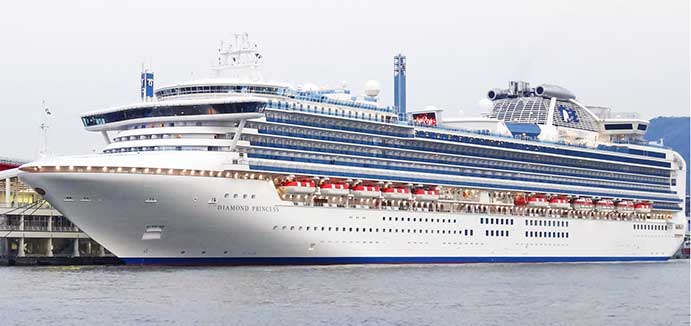
International cruise ships have been visiting Japan since the 1990s as part of their cruise itineraries. It wasn’t until 2013 when international cruise ships started offering Japan-based international cruises targeting the Japanese market.
Princess Cruises was the first major international cruise line to homeport a ship in Japan. They started with a few Japan-based cruises on the Sun Princess in 2013. Then in 2014, the Diamond Princess mega-ship was deployed to Japan and started offering international cruises starting and ending in Japan on a seasonal basis every year.
International cruise ships are mega-ships carrying thousands of passengers. They have become a game changer by giving the Japanese market a wider choice of cruise ships and lower cruise fares (especially for windowless, inside cabins). Their huge size, numerous amusement and resort facilities, and international atmosphere have appealed to more people and thereby increased Japan’s luxury cruise population.
Although Japanese cruise lines were initially wary of foreign mega-ships entering their market, the resulting increase of Japanese cruisers has benefited them as well. Since Japanese cruisers tend to try both foreign and Japanese cruise ships, the latter has also seen an uptick in customers.
The Diamond Princess was also Made in Japan by Mitsubishi Heavy Industries in Nagasaki in 2004. This made for good PR in Japan. Before coming to Japan, she underwent major refurbishment to suit the Japanese market. The ship was outfitted with a large communal bath, sushi restaurant, and Japanese food. More Japanese speakers were also included in the crew, and ship announcements were made in both Japanese and English.
At first, the Diamond Princess was more popular among Western tourists visiting Japan than Japanese customers. Western passengers still enjoyed the ship’s Japanese touches, although some were too shy to enter the communal bath completely naked with other bathers (segregated). The communal bath later became a standard amenity on Japanese cruise ships as well. The Diamond Princess became a Japan regular and well-known among cruisers and ports in Japan.
When she was stricken with COVID-19 in February 2020, she was on a Southeast Asian lunar New Year’s cruise starting and ending in Yokohama.
There are plans to bring her back to Japan for cruises from March 2023.
[Update: The Diamond Princess has restarted cruising in Japanese waters as scheduled. The bad memories associated with that ship seem to have dissipated.]
The fact that Princess ships have continued to have COVID-19 outbreaks on board may also make Japan nervous. Overseas passengers are not wearing masks like they do in Japan.
One thing about international cruise ships operating in Japan is that they are required to include a foreign port in every cruise itinerary. It’s due to the cabotage restriction disallowing foreign ships from operating only within Japan or only between domestic ports. It’s to protect Japan’s passenger ship industry. As a result, their cruises tend to be at least four or five nights long which might be a little too long for many Japanese cruise fans.
The overseas port of call is usually the nearest foreign port such as Jeju island or Busan, both in South Korea. Keelung Port (Taiwan) near southern Japan and Sakhalin (Russia) near northern Japan were also convenient ports of call, but due to Taiwan’s recent military tensions with China and Russia’s invasion of Ukraine, cruise ships may have to avoid these two ports.
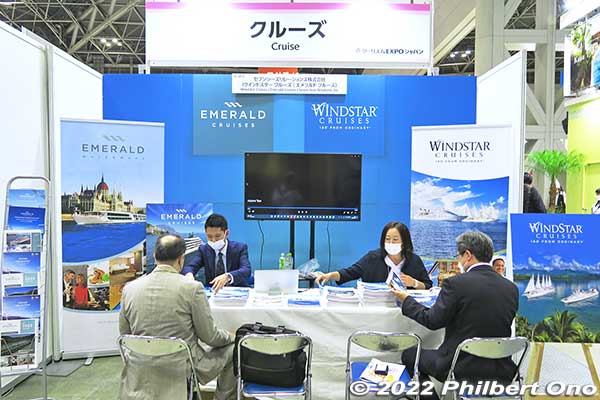
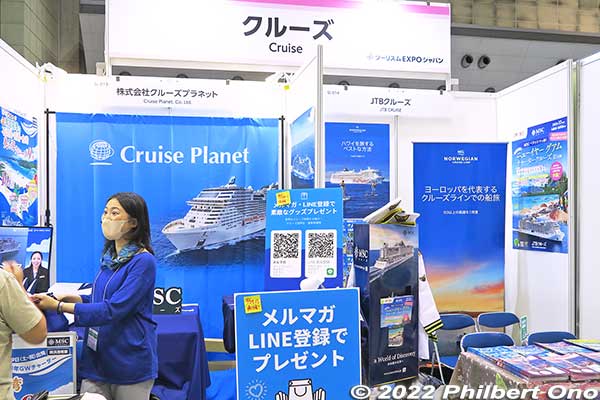
ツーリズムEXPOジャパン2022
Besides Princess Cruises, most major international cruise lines have subsidiaries or branch offices in Japan: Carnival Japan, Costa, Cunard, MSC Cruises, Norwegian Cruise Line, Silversea, etc.
They all have Japanese websites and even recently banded together in April 2021 to form their own association in Japan called Japan International Cruise Committee (JICC 日本国際クルーズ協議会). JICC members include eight international cruise companies (nine brands) and 29 cruise travel agencies. They are busy lobbying the Japanese government and port cities to reopen ports to international cruise ships.
On Nov. 15, 2022, JICC issued its first edition of guidelines for pandemic countermeasures on international cruises.
Japan still closed to international cruising (as of 2022)

Since March 2020, Japan has remained closed to international cruising. Japanese cruise ships cannot sail overseas, and international cruise ships cannot sail to Japan. The Japanese government still has not announced any timeline to reopen ports to international cruise ships and allow international cruising again.
(Update: On Nov. 15, 2022, Japan’s Ministry of Transport announced that Japan will reopen to international cruise ships and allow overseas cruises. From March 2023, international cruise ships have started cruising to and within Japan.)
One problem is that Japanese ports are still not adequately prepared to handle and screen overseas passengers for COVID-19. The reopening of Japanese ports requires the coordination and agreement of many stakeholders in government and business. They include the Ministry of Justice (Immigration); Ministry of Finance (Customs); Ministry of Health, Labour and Welfare (Quarantine); Ministry of Land, Infrastructure, Transport and Tourism (Maritime Bureau, Tourism Agency, Coast Guard); Japan Cruise Port Association (Port Authorities); local government; and cruise lines.
At each port, they need to set guidelines and protocols for foreseeable scenarios. What to do if a ship has a few or many COVID-19 cases, where to isolate COVID-19 passengers when they disembark, which medical facility to use if necessary, where to get interpreters for foreigners, how to get infected people home, etc. Lot of logistics to figure out besides putting the port city’s local residents at ease with visiting cruise ship passengers from overseas.
It will also take time to train the staff at all those ports. Japan already has experience implementing COVID-19 protocols for inbound passengers at airports, but not at seaports which have seen near zero inbound cruise ship passengers for over two years.
It’s also not encouraging to keep seeing COVID-19 outbreaks on international cruise ships overseas. Also, international cruise lines refusing to disclose COVID-19 cases on board does not bode well in Japan.
Willfully hiding COVID-19 or any other infectious diseases on board while cruising to or within Japan would be an outrage if not illegal. Japanese cruise ships have always publicly disclosed their COVID-19 cases.
Another hurdle is the disparity in COVID-19 safety protocols between Japanese and international cruise ships. COVID-19 safety protocols in the U.S. and Europe are getting looser and more tolerant than in Japan where pre-departure PCR testing and mask wearing are still the norm. Can overseas passengers on international cruise ships conform to Japanese protocols? Or do we have to wait until Japan’s safety protocols loosen enough to become more in line with the West’s?
With all these unresolved issues and worries, Japanese ports have remained closed to international cruise ships even in 2022. This has disrupted the cruise schedules of many cruise lines and chartered cruises.
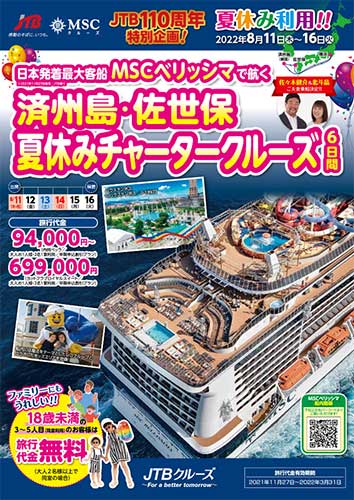
Major Japanese travel agency JTB had to cancel its six-day August 11–16, 2022 charter cruise on the MSC Bellissima mega-ship. It was going to cruise from Yokohama to Jeju island and Sasebo (Nagasaki).
JTB had sold out all the cabins (4,500 passengers), and about 30 percent of the passengers were children traveling with families.
A special family plan allowed kids age 17 and younger to cruise for free when cruising with two parents. No doubt they were looking forward to the ship’s water park and many amusement facilities for kids. Too bad.
Princess Cruises, Costa Cruises, MSC Cruises, and Windstar Cruises also had to cancel their 2022 Japan cruises. It’s a déjà vu of their Japan cruises being canceled in 2021 for the same reason.
If it’s any consolation, mega-ship cruising this summer in 2022 wasn’t a good idea anyway amid a record-breaking wave of COVID-19 infections in Japan. Even the three Japanese cruise ships had isolated cases in July–August, forcing cruises to be canceled.
Typhoon No. 8 (Tropical Storm Meari) also hit central Japan in mid-August, prompting Asuka II to cancel its festival cruise to Tokushima for the popular Awa Odori. Prime time for typhoons in Japan is July to September.
Near-future outlook

ツーリズムEXPOジャパン2022 クルーズトークショー
Japanese cruise ships are not happy with just cruising in Japan. They are itching to go overseas, and international cruise ships are itching to come to Japan. There’s a lot of pent-up demand for Japan on all fronts.
Of course, the Japanese government is aware of this and it wants to revive the tourist and cruise industries, but while minimizing the risk of coronavirus entering the country and being adequately prepared if the virus does get through.
On September 7, 2022, Japan increased the daily quota for inbound tourists from 20,000 to 50,000 and dropped the requirement for pre-departure COVID-19 testing if you had a vaccine booster. You don’t need a tour guide anymore, but tourists must still make their travel arrangements through a travel agency. Still could not travel as FIT (Free Independent Travelers). Although this is still a deal breaker for many, things were at least going in the right direction for air travelers, albeit very slowly.
Japan later abolished all these impractical requirements on October 11, 2022 in time for the fall and winter tourist seasons. The tourist industry has been clamoring to reopen Japan to inbound tourists
Meanwhile, there has been no official word for luxury cruise ships both inbound and outbound. We haven’t seen any gradual steps to reopen Japanese ports to international cruise ships nor allow Japanese cruise ships to sail overseas.
(Update: On Nov. 15, 2022, Japan’s Ministry of Transport announced that Japan will reopen to international cruise ships and overseas cruises.)
During most of 2022, people who have been overseas during the past two weeks cannot go on a luxury cruise in Japan. This rule had to be abolished before we could see international cruising in Japan again.
After restrictions on inbound tourists (by air) are completely lifted and foreign tourists prove not to be a health threat to Japan, then we can expect ports to gradually reopen to international cruising.
Despite the lingering uncertainty, Japanese cruise lines have already optimistically scheduled international cruises out of Japan. They need to shine some light at the end of the tunnel.
Nippon Maru was looking to test the international waters with an overnight cruise from Shimonoseki to Jeju island, South Korea in early November 2022. And Pacific Venus scheduled a cruise to Busan, South Korea in late November 2022. However, both international cruises were cancelled in early October 2022 because there was no official sign for international cruises being permitted by then.
Nippon Maru still has sights on its 48-day cruise to Mauritius departing Yokohama this December. And Asuka II is shooting for a cruise to Australia and New Zealand in February 2023 followed by a 104-day world cruise in April 2023.
(Update: Nippon Maru was able to go on the 48-day cruise to Mauritius as scheduled, but Asuka II canceled its world cruise in April 2023 due to the difficulty of maintaining a high level of passenger service, problems with overseas ports regarding COVID-19 measures, and regional safety and stability.)
Meanwhile, major international cruise lines like Celebrity Cruises and Norwegian Cruise Line have already canceled their Asian/Japan cruises scheduled from 2022 to spring 2023 due to the uncertainty.
However, following the Japanese Ministry of Transport’s announcement in Nov. 2022 allowing international cruising again, major cruise companies have announced plans to call on Japan again from March 2023. The Diamond Princess is planning to call on Japan at three ports in March 2023 as well as MS Amadea and MS Westerdam arriving in March 2023.
We can only hope for the best, but the cruise industry’s standard caveat still applies: Any cruise can still be canceled at anytime for any reason. Be sure to have a Plan B just in case.
Japanese Cruise Ship Vocabulary
Click item to expand it.
Essential Japanese Vocabulary – Cruise Ships
Compiled by Philbert Ono, updated: Sept. 7, 2022
Boat Types
boat/ship – fune 船
passenger ship – kyakusen 客船 or ryokakusen 旅客船. Any ship that carries paying passengers. It can be a cruise ship, ocean liner, ferry, etc. The Japanese word “kyakusen” alone often refers to cruise ships. Ryokakusen is legally defined in Japan as a boat that can carry 13 or more passengers
cruise ship – cruise-kyakusen クルーズ客船 or cruise-sen クルーズ船. Passenger ship for leisure and vacation purposes instead of transportation.
ocean liner – enyō teikisen 遠洋定期船 or taiyō kōrosen 大洋航路船. Large ship for transporting passengers across oceans on a regular schedule. At the turn of the 20th century, Japan saw many ocean liners transporting Japanese emigrants from Yokohama and Kobe Ports to Hawaii, U.S. West Coast, and South America.
After World War II until the 1950s, ocean liners were commonly used by Japanese immigrants to visit their home country. From the early 1960s, ocean liners have become largely obsolete due to air travel.
ferry (フェリー) – Transports passengers, often together with vehicles, between two ports on a regular schedule.
sightseeing boat or tour boat – yūransen 遊覧船 or kankō-sen 観光船. Small boat for short sightseeing excursions along an ocean coast, river, or lake.
sailing ship – hansen 帆船
medium-size ship – chūgata-sen 中型船
mega-ship (cruise ship) – chō-ōgata cruise-sen 超大型クルーズ船
Japanese ship – Nihon-sen 日本船
foreign ship – gaikokusen 外国船
wasen 和船 – Traditional, Japanese-style wooden boat, human-powered with a long paddle. Now used for sightseeing tours along rivers and canals.
Cruise Ship Cabins
cabin (ship) – heya 部屋
passenger cabins or guest rooms – kyakushitsu 客室
shared cabin/room – aibeya 相部屋
single cabin/room – single room シングル部屋
one’s cabin/room – jishitsu 自室
inside/interior cabin – uchigawa kyakushitsu, mado-nashi cabin 内側キャビン、内側客室、窓なしキャビン
window cabin – mado-ari cabin 窓ありキャビン
balcony cabin – balcony-tsuki cabin バルコニー付きキャビン
balcony – balcony バルコニー
suite – suite スイート
cabin/room No. – heya bango 部屋番号 or cabin bango キャビン番号
adjoining cabin – rinsetsu cabin/heya 隣接キャビン
cabin with obstructed window view – 窓の視界が遮られるキャビン
inside or within the ship – sennai 船内
Cruise Ship Parts

ship’s entrance/exit with gangway – genmon 舷門
gangway – gentei 舷梯
bridge (on a ship) – bridge ブリッジ
deck – dekki デッキ
port (ship orientation) – sagen 左舷
starboard – ugen 右舷
bow – senshu 船首
stern – senbi 船尾
midship – fune no mannaka 船の真ん中
rudder – kaji 舵
propeller – screw スクリュー
bow thruster – bow thruster バウスラスター
engine room – kikanshitsu 機関室 or エンジンルーム
galley – chorishitsu 調理室
anchor – ikari 錨
funnel – funnel ファンネル or entotsu 煙突
ship’s hull or body – sentai 船体
superstructure – jobu kozo 上部構造
draught/draft (of ship) – kissui 喫水
commemorative plaque (from ports of call) – ki’nen-tate 記念盾
boat horn – 汽笛 kiteki
no smoking – kin’en 禁煙
smoker’s area/lounge – kitsuen basho 喫煙場所 or smoking lounge スモーキングラウンジ
refurbish – kaishu 改修
Cruise Ship Activities
embark or board the ship – josen 乗船
disembark or get off the ship – gesen 下船
day of boarding the ship – josen tojitsu 乗船当日
cruise – kuruzu クルーズ
cruise canceled – cruise ga chushi クルーズが中止
voyage – funatabi 船旅
cruise itinerary – cruise schedule クルーズスケジュール
overseas/international cruise – kaigai cruise 海外クルーズ
one-night cruise – ワンナイトクルーズ
depart and arrive back at Yokohama – Yokohama hatchaku 横浜発着
set sail – shukko 出航
depart/leave the port – shukko 出港
sendoff ceremony/event – omi-okuri event お見送りイベント
arrive at the port – nyuko 入港
welcoming ceremony – kangei ceremony 歓迎セレモニー
shore excursion – optional tour オプショナルツアー
time (deadline) to return to the boat (from shore) – saishu kisen jikoku 最終帰船時刻
cruise route – koro 航路
around the world – sekai isshu 世界一周
reservations – yoyaku 予約
emergency/muster drill – hinan kunren 避難訓練
tour of the ship – sennai kengaku-kai 船内見学会
rocking (ship) – yureru 揺れる
seasick – funa-yoi 船酔い
seasick pills – yoi-dome kusuri 酔い止め薬
ship launching ceremony – shinsui-shiki 進水式 or meimei-shiki 命名式
Cruise Ship Services
front desk – front フロント
amenities – アメニティ
breakfast – choshoku 朝食
lunch – chushoku 昼食
dinner – ディナー or yushoku 夕食
night snack – yashoku 夜食
Japanese cuisine – washoku 和食
Western cuisine – yoshoku 洋食
Two dinner seating times – nikai-sei 2回制
first seating (dinner time) – ikkai-me 一回目
second seating (dinner time) – nikai-me 二回目
non-reserved seating – jiyuseki 自由席
canceled – chushi 中止
shore excursion – optional tour オプショナルツアー
tour desk – tour desk ツアーデスク
ship’s newsletter – sennai shinbun 船内新聞
carry-on bag – tenimotsu 手荷物
laundromat – laundry corner ランドリーコーナー
washing machine – sentakuki 洗濯機
laundry detergent – senzai 洗剤
clothes dryer – kansoki 乾燥機
iron (for clothing) – iron アイロン
cruise line company – kyakusen-sha 客船会社
Cruise Ship People
passenger – jokyaku 乗客 or senkyaku 船客
crew – norikumi-in 乗組員
captain – sencho 船長
purser – purser パーサー
butler – butler バトラー or shitsuji 執事
housekeeping maid – maid メイド
front desk – front フロント
concierge – concierge コンシェルジュ
waiter/waitress – waiter/waitress ウェイター/ウエイトレス
chef – chef シェフ
bartender – bartender バーテンダー
tour guide – tenjoin 添乗員
pilot – kokaishi 航海士
deckhand – kanpan-in 甲板員
Cruise Scenery and Geography

ocean – umi 海
waves – nami 波
mountains – yama 山
river – kawa
bay – wan 湾
strait – kaikyo 海峡
scenery – keshiki 景色
nice scenery – ii keshiki いい景色
sunset – yuhi 夕日
sunrise – asahi
blue – ao
green – midori
bridge (for crossing over water) – hashi
great/long bridge – ohashi
cruising under a bridge – bridge wo kuguru ブリッジをくぐる
fish – sakana 魚
dolphin – iruka イルカ
whale – kujira クジラ
shark – same サメ
land – rikuchi 陸地
port – minato 港
port town, harbor city – minato-machi 港町
sunny – hare 晴れ
cloudy – kumori 曇り
rain – ame 雨
storm – arashi 嵐
typhoon – taifu 台風
rough seas – ara-nami 荒波
big waves – onami 大波
strong winds – kyofu 強風
Cruise Ship Emergencies
emergency – kinkyu 緊急
state of emergency – kinkyu jitai 緊急事態
fire – kaji 火事 or kasai 火災
muster drill – hinan kunren 避難訓練
muster station – kinkyu shugo basho 緊急集合場所
life jacket – kyumeigu 救命具 or kyumei-doi 救命胴衣
lifeboat – kyumeitei 救命艇 or life raft kyumei ikada 救命いかだ
safety measures – anzen taisaku 安全対策
ship is flooding – shinsui 浸水
list (boat) – katamuku 傾く
sink (ship/boat) – chinbotsu 沈没
capsize (ship/boat) – tenpuku 転覆
run aground (ship) – zasho 座礁
ship in distress (accident, etc.) – suinan 水難 or sonan 遭難
power outage – teiden 停電
adrift at sea – hyoryu 漂流
cancel (cruise) – chuushi 中止
fall/man overboard – umi ni ochita 海に落ちた or 船外に落ちた
lifesaver/lifebuoy/life ring – ukiwa 浮き輪
drown – oboreru 溺れる
HELP!! – Tasukete 助けて!
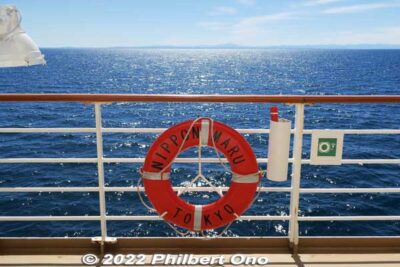
Why are so many Japanese ships named ~Maru?

by Philbert Ono, updated: Sept. 7, 2022
Like “Nippon Maru,” the names of Japanese ships commonly end with “Maru” (丸). This is due to a Japanese maritime regulation enacted in 1900 saying that “Maru” should be appended to the boat’s name as much as possible. (Not applicable to warships.) This regulation was finally abolished in 2001.
The rule was apparently influenced by past Japanese ships whose name ended with “Maru.” The earliest known Japanese ship with a “Maru” name was the Bando Maru (坂東丸) mentioned in an 1187 document owned by Ninnaji Temple (仁和寺) in Kyoto. The Edo Period (17th to 19th centuries) also saw ship names ending with “Maru.”
But why “Maru” and what does it mean with regard to ships? “Maru” literally means “round.” Nobody knows for sure. One of Japan’s great mysteries which most Japanese have wondered about at one time or another over the centuries.
There are multiple theories for the use of “Maru” and one says that “Maru” is an affectionate or personified nickname for ships similar to the names given to Japanese babies/infants, swords, and dogs which also had “Maru” or the variant “Maro” (麿). Another theory says it came from Japanese castle keeps named “maru” like “Hon-maru” (本丸). So the ship was an extension of the daimyo lord’s castle.
Still another theory says it could be from toimaru (問丸), a wholesaler in port towns who handled the shipping and sale of rice paid as government taxes from the 11th century. The toimaru named its ships after its business name ending with “Maru.”
Internationally, Japanese ships are commonly referred to as “Maru ships.” Even the Star Trek universe had a space ship (freighter) named “Kobayashi Maru.” How entertaining that was.
BTW, unlike in English, ships are never referred to as “she” or “her” in Japanese.
Essential Japanese Vocabulary – Ports (Click to open)
Compiled by Philbert Ono, updated: Sept. 7, 2022

port – minato 港
port of call – kikōchi 寄港地
call on a port – kikō suru 寄港する
pier – sanbashi 桟橋
pier/dock/wharf – futō 埠頭
dock or dockside – ganpeki 岸壁
arrive at port – nyūkō 入港
leave port – shukkō 出港
set sail – shukkō 出航
boat/ship – fune 船
board the boat – jōsen 乗船
disembark – gesen 下船
depart and return to Yokohama – Yokohama hatchaku 横浜発着
boat entering the port – irifune 入船
boat leaving the port – defune 出船
boat returning home – kaeri-bune 帰り船
boat separating you and someone on board (farewell parting) – wakare-bune 別れ船
Shinko – 新港 literally meaning “New Port,” this is a common term used at large ports having many piers to indicate the newest port dock. For example, Toyama Shinko Port and Shinko Pier at Yokohama Port.
home port – bokō 母港
at port, docked – teihakuchū 停泊中
moor – keiryū 係留
hawser – ホーサー thick rope to moor the boat
bollard – bit ビット or bollard ボラード (係船柱)
port town/city, harbor city – minato-machi 港町
bay – wan 湾
terminal – terminal ターミナル
CIQ (Customs Immigration Quarantine) – CIQ
Customs – zeikan – 税関
Immigration – shutsu-nyūkoku kanri 出入国管理
Quarantine – ken’eki 検疫
land – rikuchi 陸地
final port (during a cruise) – kichaku-kō 帰着港
tender boat – tsusen 通船
go ashore – jōriku 上陸
shore excursions – optional tours オプショナルツアー or kikōchi kankō 寄港地観光、
tour bus – kankō bus 観光バス
tour on your own on shore – jiyu kōdō 自由行動
return to the boat – kisen 帰船
time to return to the boat – saishu kisen jikoku 最終帰船時刻
Next: Japanese Cruise Ships
Content Navigator
State of Japanese Cruise Industry in mid-2022 (Current page)
- COVID-19 not over yet
- International cruise ships in Japan
- Japan still closed to international cruising
- Essential Japanese Vocabulary
- Ship comparison
- Japanese cruise ship advantages
- COVID-19 protocols
- Basic cruise rules
- Safety Record
- FAQ
- Asuka II
- Nippon Maru
- Pacific Venus
Ports for Cruise Ships in Japan
- Cruise ship departure ports
- Japan’s popular ports of call
- Shore excursions
- Mega-ships and harbor bridges
- Japanese port history
- Port town songs
- Major Japanese Ports: Yokohama | Tokyo | Kobe | Hakodate | Nagoya | Kanazawa | Toyama
